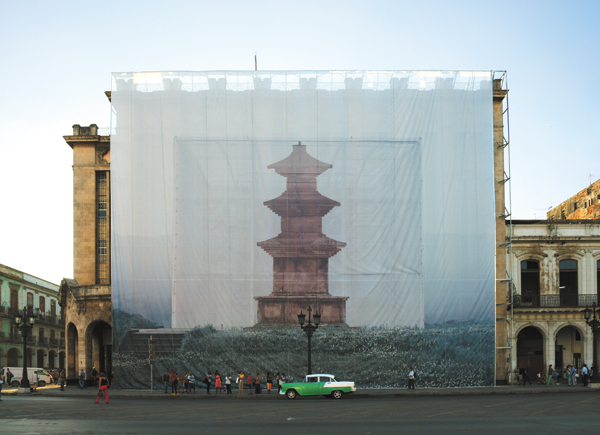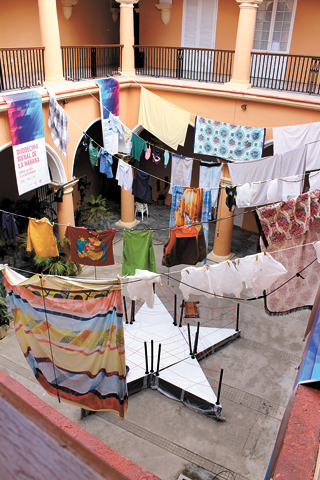Biennial marks changes in Cuba, Korea relations

Korean artist Han Sungpil’s work “Harmonious Havana” is installed on a building across the street from El Capitolio, a major landmark in the Cuban capital, as part of the ongoing 12th Havana Biennial art festival. The 28-meter by 33-meter screen carries a photograph the artist took of a seventh-century stone pagoda in Gyeongju, an ancient city in the southern part of Korea. The photo below shows El Capitolio and the work facing each other. Provided by the artist
The work was created by Korean artist Han Sungpil, part of the ongoing Havana Biennial, the 12th of its kind. He installed the 28-by-33-meter (30.62 by 36 yard) screen, which holds a photo he took of the seventh-century stone pagoda, on the facade of a building across the street from El Capitolio.
As a result, the monuments of two far-distant cultures are now separated by just a road.
The photo of Han’s “Harmonious Havana” installation appeared on the front page of Granma, Cuba’s leading newspaper, on May 23.
“It is rare for the official newspaper of the Cuban Communist Party to feature South Korean culture, and it is the first time for a photo related with South Korea to appear on its front page,” said Joung Ho-hyun, a Korean film director living in Havana who leads cultural exchanges between the two countries.
Granma was named after the yacht that transported 1953-59 Cuban Revolution fighters - including the iconic Che Guevara, the former leader Fidel Castro, and the current President Raul Castro, his brother. When the revolution was successful and Communism was brought in, Korea severed diplomatic relations with the country.

Among Cuban-born artist Glexis Novoa’s satirically small wall paintings of the world’s political monuments is a statue of North Korea’s former leader Kim Il Sung, left. Nigerian artist Victor Ekpuk’s on-site mural using only white chalk on a wall, above, at Havana’s Wifredo Lam Centre of Contemporary Art explains the culture of the Abacua people who migrated from the African country to Cuba in the 18th century. Far above, Cuban artist Alexander Guerra Hurtado’s sculpture depicting the Facebook “like” icon installed along the Malecon has an ironic gesture. By Moon So-young
Having first launched in 1984, this year’s arts festival is generating more of a buzz with U.S. art experts and tourists as a result of Cuba agreeing to begin the process of normalizing relations with the United States last December.
Thirty-five U.S. artists - a larger number than ever - are participating in the 2015 edition of the Havana Biennial, titled “Between Ideas and Experience,” according to its artistic director, Margarita Gonzalez Lorente. The show takes place in dozens of the Cuban capital’s museums and libraries, as well as on the city’s streets, with a total of 200 artists from 44 countries getting involved. Some big names such as France’s Daniel Buren, India’s Anish Kapoor and Germany’s Tino Sehgal are included in this number.
South, not North, in Cuba
When sunset approaches, the blue shadow of El Capitolio’s dome is overlapped with the image of Gameunsa Temple’s pagoda in “Harmonious Havana,” as if symbolizing the possibility of intimate communication between Cuba and Korea in the future.
“This is the moment I like the best for my work,” said Han on the afternoon of June 22, when the 2015 Havana Biennial opened. “I’d like to give people here a strange and funny experience by juxtaposing and mixing Cuban and Korean cultures. This moment completes my intention.”
The installation process for the site-specific work did not go smoothly, Han explained, smiling.
“The process was much slower than expected, which nearly drove me into a panic,” the 43-year-old artist said, adding that the scaffolds bolstering the screen were much weaker than the ones he uses for his work elsewhere in Korea and in other countries, perhaps because of the “chronic shortage of materials” in Cuba.
Havana commuters, awaiting a ride at a bus stop with Han’s installation as a backdrop, looked just like travelers to the real pagoda in Gyeongju, an ancient city in the southern part of Korea.

Aruban artist Nelson Gonzalez recreates an ordinary street scene in Havana with clothes donated by Cubans at one of the event’s main venues. By Moon So-young
Among the onlookers was Javier Labrador, a Cuban cinematographer.
“It’s so cool that the pagoda’s image is overlapped with the shadow of El Capitolio’s cupola,” he said. “I’ve never been to Korea but know the country somewhat because a movie my girlfriend and I co-directed was invited to the 2014 Jeonju International Film Festival, and so she visited Korea during the festival.”
The movie, “Hotel Nueva Isla,” was released last year.
Calling Han’s work “beautiful,” Ray Casamayor, who was accompanying Labrador, said, “I’m greatly interested in Asian art. I saw some at the Met [Metropolitan Museum of Art] in New York. But here in Cuba, we don’t have many chances to see them.”
Including these two, many Cubans that the Korea JoongAng Daily met on the streets were aware of Korea. Most of them took “Korean” to mean the South rather than the North, even though Havana and Pyongyang have kept close ties.
“In recent years, about 5,000 South Korean tourists a year came to Cuba,” explained Joung, the Korean film director. “And Hallyu [the Korean Wave] is spreading among Cuban people. Korean TV dramas are very popular here, but K-pop is not so strong in this country, where many Latin music originates.”
Economic as well as cultural exchanges have been activated since the Korea Trade-Investment Promotion Agency opened a Havana office in 2005. Under such an atmosphere, the establishment of diplomatic relations between the two countries will come “in the near future,” said Chun Beeho, the Korean ambassador to Mexico, who also now covers affairs related with the Caribbean country.
Cuba is one of the four nations in the world that Korea has no diplomatic relations with.
A thaw in ties but a mixed reality
Other exhibits at the 2015 Havana Biennial also show the ongoing or upcoming changes of Cuba.
Sehgal, a famous performance artist, encourages visitors to the Wifredo Lam Contemporary Art Center in Old Havana to discuss what they think about the free-market economy with two Cuban volunteers who majored in economics.
After the talk attendees are paid a Cuban peso, going against the common capitalist idea that audiences should pay a fee to museums or artists. This aims to encourage people in socialist Cuba and visitors from free-market countries to re-think their own systems and about what shifts the expected inflow of capitalism into Cuba following the improvement in relations with the U.S. will bring.
Among the artworks installed along the Malecon, Havana’s long stone seawall, is a giant sculpture of the social networking service Facebook’s “like” thumb icon.
“Through the icon of the American online service’s icon is seen the fortress; it is ironic,” said the Cuban artist Alexander Guerra Hurtado, pointing to the 16th-century Morro-Cabana.
Che Guevara used the fortress as a military headquarters during the Cuban Revolution.
The Malecon, over which the sapphire-blue sea spreads, is not only a famous tourist spot but also a favorite of locals for strolling and fishing, especially at sunset.
Most of the pieces installed here are under the “Behind the Wall” theme and were created to bring ordinary people closer to art in an easy to understand, humorous and interactive way.
The installations include an ice-skating rink built by U.S.-Irish artist Duke Riley, where Cubans, who live in a tropical climate, can experience skating, and a red slide by a local, Liudmila Lopez.
Many decayed buildings along the Malecon were being restored or renovated into hotels and restaurants as more foreign tourists are expected to come to Cuba with the inflow of capitalism and the expected improvement in relations with the U.S.
But some say the Communist nation will not change its political conditions so easily, as suggested by Cuban artist Tania Bruguera case.
Bruguera was temporarily detained by the Cuban censorship authorities on May 24 after she staged a live reading of Hannah Arendt’s 1951 book “The Origins of Totalitarianism.”
She had already been arrested by Cuban authorities on multiple occasions earlier this year.
While the controversy continues, so does the collaboration between U.S. artists and Cuba - the first art museum exchange between Cuba and the U.S. in nearly 50 years is ongoing as part of the biennial.
An exhibition titled “Wild Noise,” now at the National Fine Arts Museum in Old Havana, has drawn from the Bronx Museum of the Arts in New York collection, which features more than 90 pieces by 50 artists from the U.S. establishment’s permanent collection.
In exchange, the Bronx Museum will host an exhibition of works from the Cuban museum’s collection in the U.S. in 2016.
BY MOON SO-YOUNG [symoon@joongang.co.kr]










with the Korea JoongAng Daily
To write comments, please log in to one of the accounts.
Standards Board Policy (0/250자)